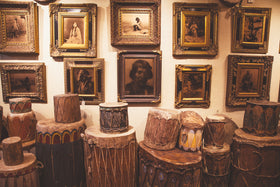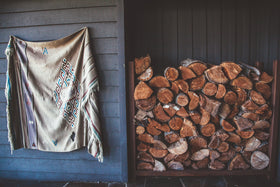Anasazi Pottery

The Anasazi " Ancient Ones" are the ancestors of the modern Pueblo Indians that inhabited the Four Corners country, Southern Utah, Southwestern Colorado, Northwestern New Mexico and Northern Arizona. At least from the time of Jesus and possibly before, the Anasazi occupied a huge chunk of mostly arid and barren real estate. There are hundreds of thousands of sites throughout this immense area ranging from caves and individual campsites to multi-story adobe pueblos and magnificent cliffside stone cities. The Anasazi abandoned major cities like Mesa Verde and Chaco near the end of the 13th Century migrating to the Rio Grande Valley. Current historians extend the time of the Anasazi to 1700. Left behind was their pottery which can be identified by material, form and design.
The Anasazi culture is best known for their stone and earth dwellings built along cliff walls. The best examples are now protected within the National Parks such as Navajo National Monument, Chaco Cultural National Historical Park, Mesa Verde National Park, Canyon de Chelly National Monument and more.

They are also known for their pottery. In general, pottery used for cooking or storage was unpainted, gray and either smooth or textured. Pottery used for more formal purposes was often more richly decorated. In the Northern territory from around 500-1300 AD the most common decorated pottery had black painted designs on a white or light gray background. Decorations characterized by fine etching and contrasting colors were produced by the use of a mineral based paint on a chalky background. In the Southern territory throughout the Mogollan settlements, pottery was more often hand coiled, scraped and polished with red to brown coloring.

Casas Grande Polychrome Jar
To view more examples of Prehistoric Southwestern Pottery click here.
Changes in pottery composition and decorations provide a time chart. Late 14th and 15th Century pottery in Central Arizona was widely traded.
Defining cultural groups tends to create an image of territory separated by clear cut boundaries. These did not exist. Prehistoric people traded, worshiped, collaborated and fought most often with other nearby groups.

Each clan or family group developed their own style and those evolved over the centuries as well. Examples of the clan/tribes are Sinagua, Salato, Hohokam, Mogollan, Kayenta, Mesa Verde, Four Mile, St. Johns, Casas Grandes, Yuman, Show Low, Chaco, Tularosa, Gila, and Red Mesa.
Cisco's has amassed an exceptional collection of Prehistoric Southwestern Pottery including utilitarian pieces such as bowls and ladles as well as decorative and ceremonial pieces. Find the perfect piece for your home today!
The Anasazi culture is best known for their stone and earth dwellings built along cliff walls. The best examples are now protected within the National Parks such as Navajo National Monument, Chaco Cultural National Historical Park, Mesa Verde National Park, Canyon de Chelly National Monument and more.

Mesa Verde National Park
They are also known for their pottery. In general, pottery used for cooking or storage was unpainted, gray and either smooth or textured. Pottery used for more formal purposes was often more richly decorated. In the Northern territory from around 500-1300 AD the most common decorated pottery had black painted designs on a white or light gray background. Decorations characterized by fine etching and contrasting colors were produced by the use of a mineral based paint on a chalky background. In the Southern territory throughout the Mogollan settlements, pottery was more often hand coiled, scraped and polished with red to brown coloring.

Casas Grande Polychrome Jar
1205-1340 AD
Most tall cylinders are considered ceremonial vessels. Narrow neck jars were used for liquids. Pottery in the Southern territory after 1150 AD is characterized by heavier black-line decoration and the use of carbon based colorants. In the Northern territory, the black on white tradition continued well after 1300 AD.To view more examples of Prehistoric Southwestern Pottery click here.
Changes in pottery composition and decorations provide a time chart. Late 14th and 15th Century pottery in Central Arizona was widely traded.
Defining cultural groups tends to create an image of territory separated by clear cut boundaries. These did not exist. Prehistoric people traded, worshiped, collaborated and fought most often with other nearby groups.

Each clan or family group developed their own style and those evolved over the centuries as well. Examples of the clan/tribes are Sinagua, Salato, Hohokam, Mogollan, Kayenta, Mesa Verde, Four Mile, St. Johns, Casas Grandes, Yuman, Show Low, Chaco, Tularosa, Gila, and Red Mesa.
Cisco's has amassed an exceptional collection of Prehistoric Southwestern Pottery including utilitarian pieces such as bowls and ladles as well as decorative and ceremonial pieces. Find the perfect piece for your home today!




